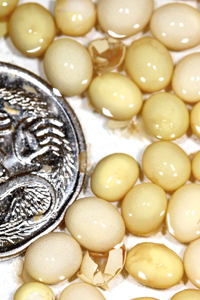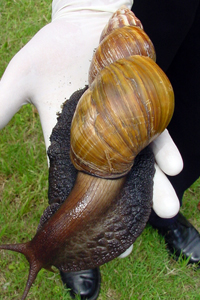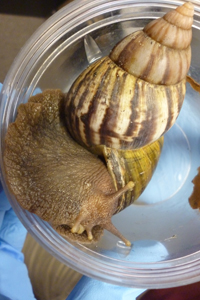The giant African snail is one of the world’s largest and most damaging land snails. Native to Eastern Africa, it has quickly spread around the world and is now established in most tropical countries. Australia is free from the giant African snail and we want to keep it that way.



Note: images are not to size
The risk to Australia
Giant African snail feed on more than 500 species of plants, including legume crops, ornamental plants, vegetables and the bark of large trees such as citrus and pawpaw. They are a serious risk to Australia’s horticultural industries; their ferocious appetite is capable of destroying vegetable crops, fruit trees and Australia’s native eucalypt forests.
What the giant African snail looks like
Adult snails are very large with a long, narrow, cone-shaped shell. The shell is usually 50 to 100 millimetres long but can reach up to 200 millimetres. They can vary in colour however they are usually light brown, with alternating brown and cream bands on their upper whorls. All adult snails have both male and female sexual organs.
Eggs are 4.5 to 5.5 millimetres in diameter and are cream to yellow in colour. They are oval in shape and each batch can have between 100 and 400 eggs. In a typical year, every mated adult lays about 1200 eggs.
Where and what to look for
Adult snails can be found attached to shipping containers, machinery and motor vehicles. Sometimes, snail trails may also be seen. Eggs can be carried in soil associated with imported goods.
SEE. SECURE. REPORT.
If you see this pest or any other pest that you think may have hitchhiked to Australia, contain it where possible and immediately report it to the Department of Agriculture Fisheries and Forestry on 1800 798 636.
For safety, consult a departmental entomologist before handling specimens.
